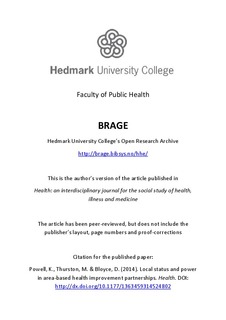Local status and power in area-based health improvement partnerships
Journal article, Peer reviewed
Permanent lenke
http://hdl.handle.net/11250/194458Utgivelsesdato
2014Metadata
Vis full innførselSamlinger
Originalversjon
Powell, K., Thurston, M. & Bloyce, D. (2014). Local status and power in area-based health improvement partnerships. Health. doi: 10.1177/1363459314524802 10.1177/1363459314524802Sammendrag
Area-based initiatives (ABIs) have formed an important part of public policy towards more socio-economically deprived areas in many countries. Co-ordinating service provision within and across sectors has been a common feature of these initiatives. Despite sustained policy interest in ABIs, little empirical work has explored relations between ABI providers and partnership development within this context remains under-theorised. This paper addresses both of these gaps by exploring partnerships as a social and developmental process, drawing on concepts from figurational sociology to explain how provider relations develop within an ABI. Qualitative methods were used to explore, prospectively, the development of an ABI targeted at a town in the north west of England. A central finding was that, although effective delivery of ABIs is premised on a high level of coordination between service providers, the pattern of interdependencies between providers limits the frequency and effectiveness of cooperation. In particular, the interdependency of ABI providers with others in their organisation (what is termed here ‘organisational pull’) constrained the ways in which they worked with providers outside of their own organisations. ‘Local’ status, which could be earned over time, enabled some providers to exert greater control over the way in which provider relations developed during the course of the initiative. These findings demonstrate how historically constituted social networks, within which all providers are embedded, shape partnership development. The theoretical insight developed here suggests a need for more realistic expectations among policy makers about how and to what extent provider partnerships can be managed.
Beskrivelse
This is the author's version before it was sent to the publisher. Therefore, it may differ slightly from the published version. For the published version, please go to: http://hea.sagepub.com/content/early/2014/03/28/1363459314524802.refs.html
